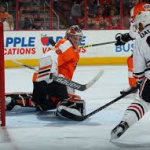
Penguins – Capitals X’s & O’s
When the Penguins had some trouble with the New York Rangers in the first two games of Round 1, two players at the forefront of who were struggling on the backend were Trevor Daley and Olli Maatta.
In the Penguins losing their second game of the post-season Thursday night and their first in Round 2 in going down 1-0 to the Capitals, Daley and Maatta had their share of troubles. While Brian Dumoulin is taking some heat from other publications, Daley and Maatta’s play were more concerning.
For Daley he struggled all game with the Capitals pressure and exiting the zone.
He was on the ice for three even strength goals against, including the overtime winner where he turned the puck over on a poor clearing attempt in the neutral zone (when pressured) than was out-muscled in front by Alexander Ovechkin that prevented him giving strong side help to Matt Murray on Oshie’s wrap around.
Things were bad for him from the start.
In the first period, Daley was on the ice for 4 shot attempts, 13 against 5 v 5, with the Dumoulin – Daley pairing (15 CF% together in 1st period) hemmed in their own end for much of the period. In periods 2-3 + overtime, Daley was still in the negative (11/15) and 14/28, 33 CF% overall for the game at even strength.
With Olli Maatta a disaster in the game, coughing up the puck in the offensive zone leading to a T.J. Oshie breakaway goal with the Penguins up 2-1, — than showing awful reaction time on Oshie’s go-ahead goal in the third, — the coaching staff had no choice but to split up the top two pairs.
Daley with Maatta in Game 1 (one the ice for 5 shot attempts, 13 against)
Daley with Dumoulin in Game 1 (on the ice for 5 shot attempts, 13 against)
D-Pairs Goals Against
Daley – Dumoulin (Burakovsky goal)
Maatta – Letang (Oshie Breakaway Goal)
Daley – Maatta (Oshie go-ahead goal)
Daley – Dumoulin (Oshie OT Winner)
Daley was on the ice for the 5 even strength goals in the first two games vs the Rangers. He was able to rectify himself with a very strong Game 3. The Capitals, though, are a different animal and there’s some talk Daley might also be favoring an injury.
Daley has to be an impact player for the Penguins in this series, especially with how much of a liability Olli Maatta is. Maatta’s at the point where he’s just a lost cause for this season, especially when it comes to consistently playing at an impact top-2 pairing level the Penguins need. It’s just not going to happen. Kris Letang can only hide so much.
It’s not just the lack of foot-speed for Maatta. From his decision making to his reaction time, everything is just a step slow. The Penguins are playing with fire here with him.
Penguins exploit Capitals Bottom-pairing D
Talked prior to the series about the bottom pairing d-men for both teams being areas of concerns.
The Penguins third pairing held their own.
Ben Lovejoy scored Pittsburgh’s first goal and the Cole – Lovejoy pairing was on the plus-side in the Penguins driving possession and they were on the ice for no goals against.
When the Cole-Lovejoy pairing was on the ice, the Penguins drove possession on 59% of their shot attempts (17/12)
Not the same story for the Capitals when it came to their bottom-d.
Nate Schmidt and Dmitry Orlov both have problems in how they over-commit and get themselves out of position. The Penguins exploited this in the regular season and did so again in Game 1 from the drop of the puck with the tipping point being Nick Bonino walking Orlov at the blueline on the Lovejoy goal in period two.
Orlov would leave the game and basically put the Capitals with four defenseman as they didn’t trust Schmidt out there late and Brooks Orpik also looked tentative as illustrated on Bonino’s game tying goal.
For the Capitals, Schmidt was on the ice for two of the three even strength goals against and the same for Orpik.
Penguins win the neutral zone
A positive for the Penguins was their ability to win the neutral zone, though, the puck management issues once they gained the zone had them playing some dangerous hockey.
Even in the first period and early in the second when the Capitals were controlling the game, Pittsburgh was gaining the offensive zone effectively. The issues the Penguins had was Washington closing their gaps extremely well and forcing turnovers just inside the blueline.

To read this insider news, subscribe to get “Inside Access”!


